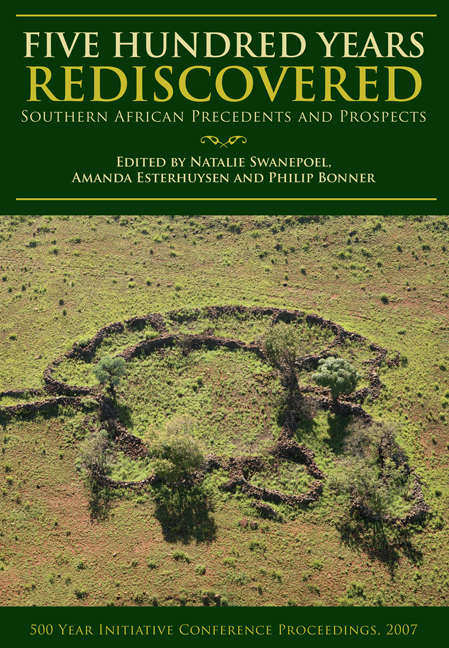Book contents
- Frontmatter
- Contents
- Preface
- 1 Introduction
- Section 1 Disciplinary Identities: Methodological Considerations
- 2 Historical archaeologies of southern Africa: precedents and prospects
- 3 South Africa in Africa more than five hundred years ago: some questions
- 4 Towards an outline of the oral geography, historical identity and political economy of the Late Precolonial Tswana in the Rustenburg region
- 5 Metals beyond frontiers: exploring the production, distribution and use of metals in the Free State grasslands, South Africa
- 6 deTuin, a 19th-century mission station in the Northern Cape
- 7 Reinterpreting the origins of Dzata: archaeology and legends
- Section 2 Material Identities
- Section 3 ‘Troubled Times’: Warfare, State Formation and Migration in the Interior
- List of contributors
- Index
6 - deTuin, a 19th-century mission station in the Northern Cape
from Section 1 - Disciplinary Identities: Methodological Considerations
Published online by Cambridge University Press: 30 May 2019
- Frontmatter
- Contents
- Preface
- 1 Introduction
- Section 1 Disciplinary Identities: Methodological Considerations
- 2 Historical archaeologies of southern Africa: precedents and prospects
- 3 South Africa in Africa more than five hundred years ago: some questions
- 4 Towards an outline of the oral geography, historical identity and political economy of the Late Precolonial Tswana in the Rustenburg region
- 5 Metals beyond frontiers: exploring the production, distribution and use of metals in the Free State grasslands, South Africa
- 6 deTuin, a 19th-century mission station in the Northern Cape
- 7 Reinterpreting the origins of Dzata: archaeology and legends
- Section 2 Material Identities
- Section 3 ‘Troubled Times’: Warfare, State Formation and Migration in the Interior
- List of contributors
- Index
Summary
Introduction
The excavation of graves from the historic burial ground at deTuin will probably be the last time an archaeological project in South Africa is allowed that specifically excavates human remains for research purposes. Fourteen graves were opened between 1982 and 2002 with the express purpose of identifying who was buried there. The site was known as a temporary station of the Rehoboth people in the 1860s, and the descendant community in Rehoboth, Namibia, was contacted about the project and was kept informed of progress.
The property deTuin is presently a stock farm on the Tuins River (Fig. 6.1) about 50 km west of the town of Kenhardt in the Bushmanland region of the Northern Cape Province (29°22.3|S; 20°41|E). The region as a whole is generally without surface water and all of the farms in the district are supplied with water by borehole. Although the stock on modern deTuin is also watered in this manner, occupation of the site previous to the drilling of boreholes has been possible because of the presence of a permanent brackish spring in the river bed. In particular, deTuin is known as having been the location of a Rhenish mission settlement between the years 1863 and 1868.
The presence of large numbers of graves on deTuin was brought to the attention of Professor A.B. Smith during 1979, and it was decided to investigate the site for possible excavation. The first expedition to deTuin occurred in 1982 under my direction. Three grave sequences were identified, one of these sequences was mapped, and two graves were excavated. The site was again visited in 1994 by Morris when a second grave sequence was mapped and one further grave was opened. A further field season took place in 1995 when four more graves were excavated under the direction of Dr G. Louw. Tanya Peckmann took over the deTuin excavations as part of her PhD project and completed the examination of three graves in 1999 and a final four graves in 2000 (Peckmann 2002). In all, fourteen graves were excavated and these, along with some more general archaeological observations, are the basis for the report which follows.
- Type
- Chapter
- Information
- Five Hundred Years RediscoveredSouthern African precedents and prospects, pp. 103 - 118Publisher: Wits University PressPrint publication year: 2008



